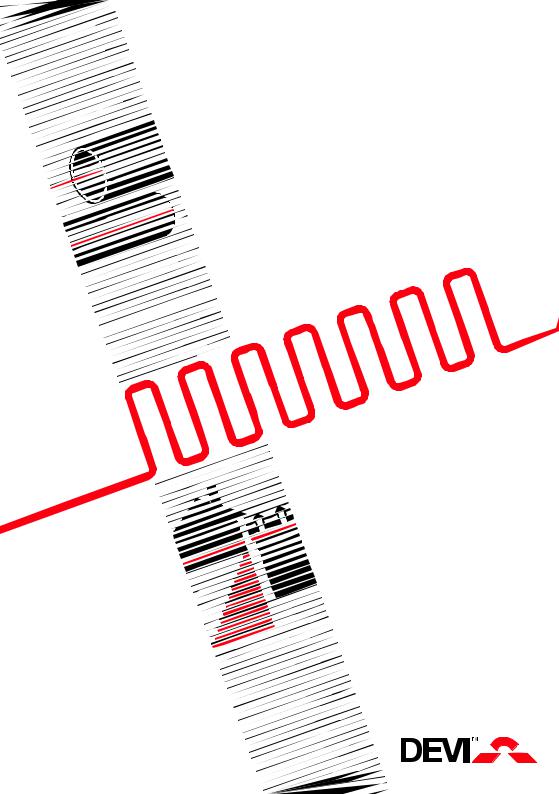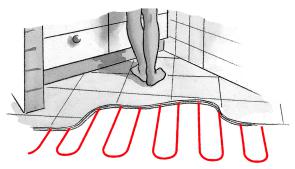Danfoss DTIE-6, DTIE-10, DTIE-17, DSIA-25, DSIA-300 Operating guide

GB/DAS |
Installation Instructions |
|
Deviflex™ heating cables |
|
Deviflex™ DTIE-10/17 |
|
for thin floor constructions, |
|
cement floors, etc. |
www.devi.com

Notes

Deviflex™ DTIE-10 and DTIE 17 heating cables
Deviflex™ type DTIE is a 2-wire heating cable. The cable is CE-Marked, and NEMKO certified in accordance with IEC 60800. The cable is suitable for both indoor and outdoor use, and may be
attached directly to any mesh reinforcement.
Please consult the table below for the correct choice of cable.
Areas of use
Installation |
Normal W/m2 |
Max. W/m2 |
DTIE-17 |
DTIE-10 |
|
Bathroom floor |
120 |
- 150 |
200 |
X |
|
Living room |
80 |
- 100 |
100 |
X |
X |
Porch |
120 |
- 150 |
200 |
X |
|
Hall |
100 |
- 140 |
200 |
X |
|
WC |
70 |
- 100 |
200 |
X |
X |
Bedroom |
70 |
- 100 |
100 |
X |
X |
Corridor |
70 |
- 100 |
200 |
X |
|
Child’s bedroom |
70 |
- 100 |
100 |
X |
X |
Basement room |
70 |
- 100 |
100 |
X |
X |
Laundry room |
120 |
- 150 |
200 |
X |
|
Ground heat |
40 |
- 60 |
|
|
X |
Kindergarten |
50 |
- 70 |
|
|
X |
Thin floors |
|
|
|
|
X |
Office |
80 |
- 100 |
100 |
X |
X |
Gutters, |
30 |
- 40 |
|
|
|
per metre gutter |
|
X |
|
||
Cable specifications
Cable |
Deviflex™ DTIE-10, and |
Type |
DTIE-17 |
2-wire with screen |
|
Voltage |
230 V |
Output |
10 og 17 W/m |
Diameter |
Ø 6 mm |
Cold tail |
2,5 m - 2 x 1,5 mm2 |
Conductor |
with screen |
|
|
insulation |
Flourplast |
Inner casing |
PEX (polyethylene) |
Sheath |
Polyolefin |
Max. temperature |
65ºC |
Recommended areas of use – Deviflex™ DTIE-10
|
Surface |
c-c distance |
|
output |
20 - 12 cm |
Standard |
50-80 W/m2 |
20 - 12 cm |
concrete |
|
|
|
|
|
Thin floor |
80-125 W/m2 |
12 - 8 cm |
construction |
|
|
|
|
|
Recommended areas of use – Deviflex™ DTIE-17 |
||
|
|
|
|
Surface |
c-c distance |
Vanlig støp |
output |
22 - 8 cm |
Standard |
75-200 W/m2 |
22 – 8 cm |
concrete |
|
|
|
|
|
Bathroom |
125 -200 W/m2 |
15 - 8 cm |
Thin floor |
125-150 W/m2 |
14 - 11 cm |
construction |
|
|
|
|
|

General Installation instructions
The following guidelines must be observed when installing the heating cable:
1.The heating cable must be installed with a fixed connection (not a plug socket).
2.An authorized electrician must connect the heating cable to the thermostat.
3.The specified maximum output for various installation and operating conditions must be respected.
4.The heating cable must be protected against mechanical stress at all times and must never be stretched.
5.Clean the surface and remove any sharp objects.
6.The flex diameter of the cable must not be less than 6 x the cable diameter.
7.Ensure that the cable do not touch or cross one another.
8.Do not lay the connection box and the end of the heating cable in wet areas such as showers or under bathtubs, etc.
9.Do not lay the heating cable under built-in baths, cupboards, walls, etc.
10.Connect the earth wire of the heating cable in accordance with regulations.
11.Do not shorten the heating cable as this will increase the output per metre cable.
12.Check the insulation resistance and the resistance of the heating cable once it has been installed, both before and after the concrete is poured. The resistance of the cable must be as specified on the label: -5
– +10%.
13.It should still be possible to move the heating cable after attaching any type of fixing strips.
14.The heating cable must be equipped with a circuit breaker. In addition, we recommend the use of a Devireg™ thermostat.
15.The cable is marked every one-meter but please note that smaller deviations compared to the cable’s actual length might occur. The meter marking is only meant as a help when laying out the cable.
Fig. 1
The heating cable should not be installed at temperatures below –7°C. If you have to lay the cable at low temperatures, try connecting the cable for a short while as this
will make it easier to install. Please note that the cable must, in this case, be rolled out to keep the cable temperature from getting too high.
